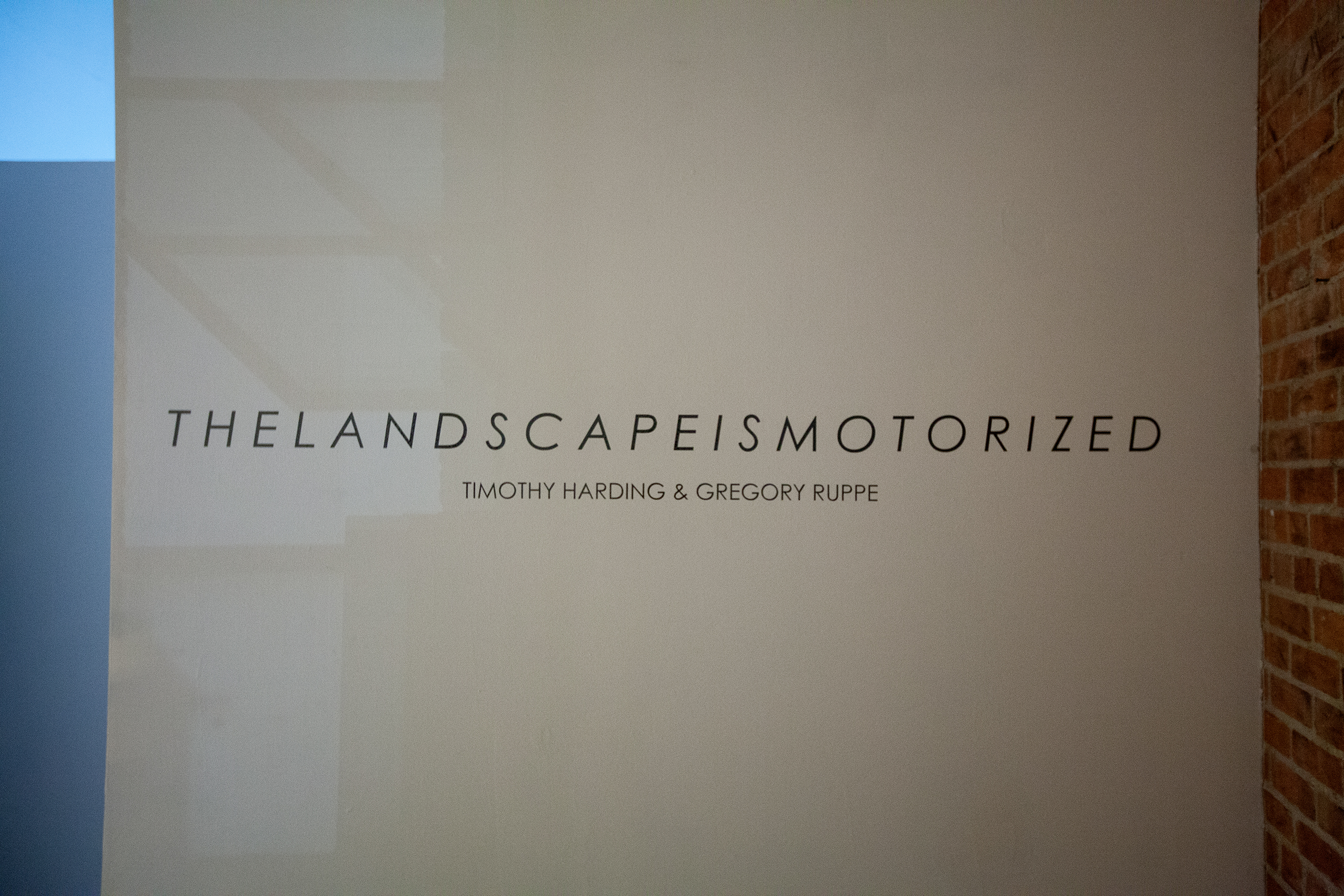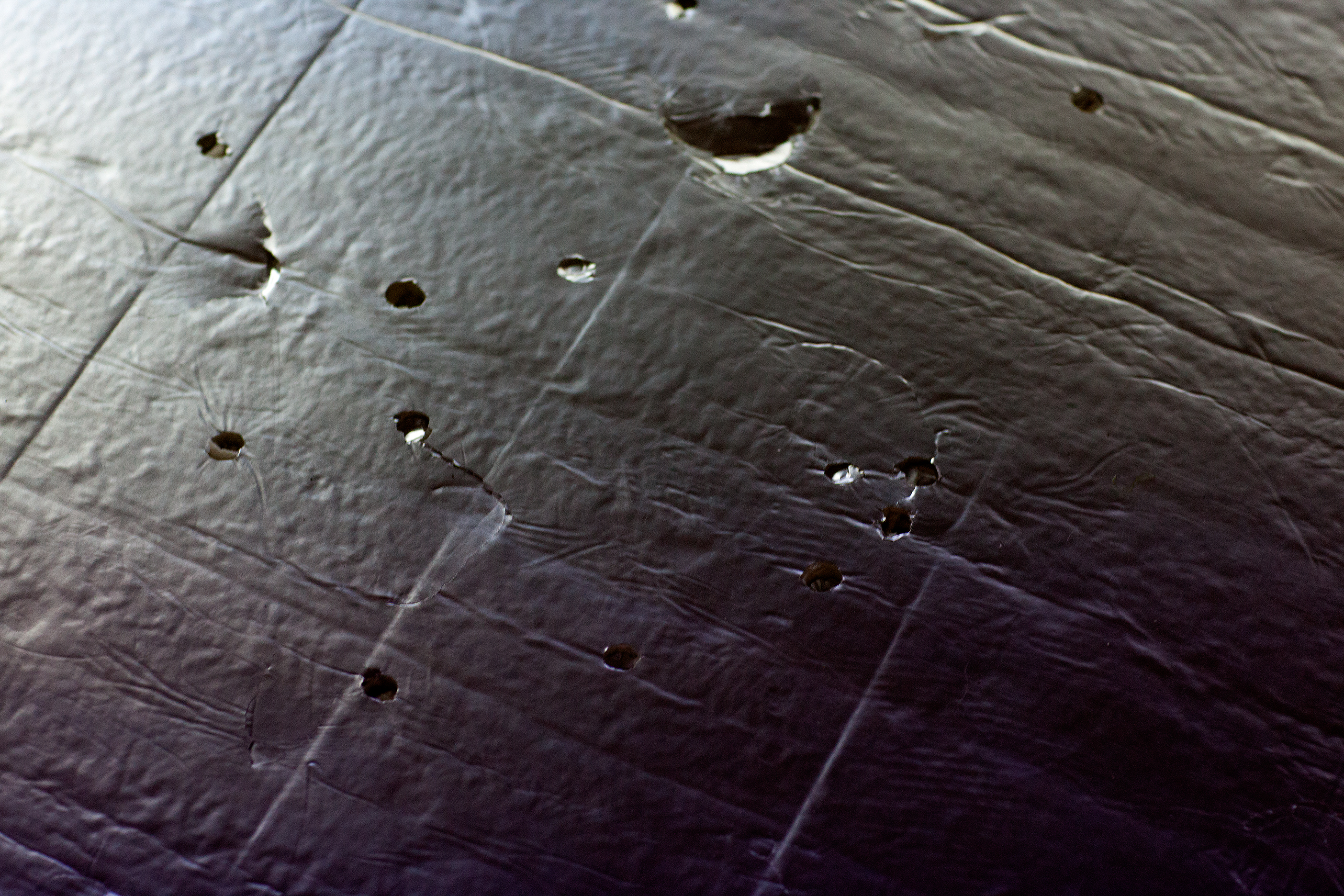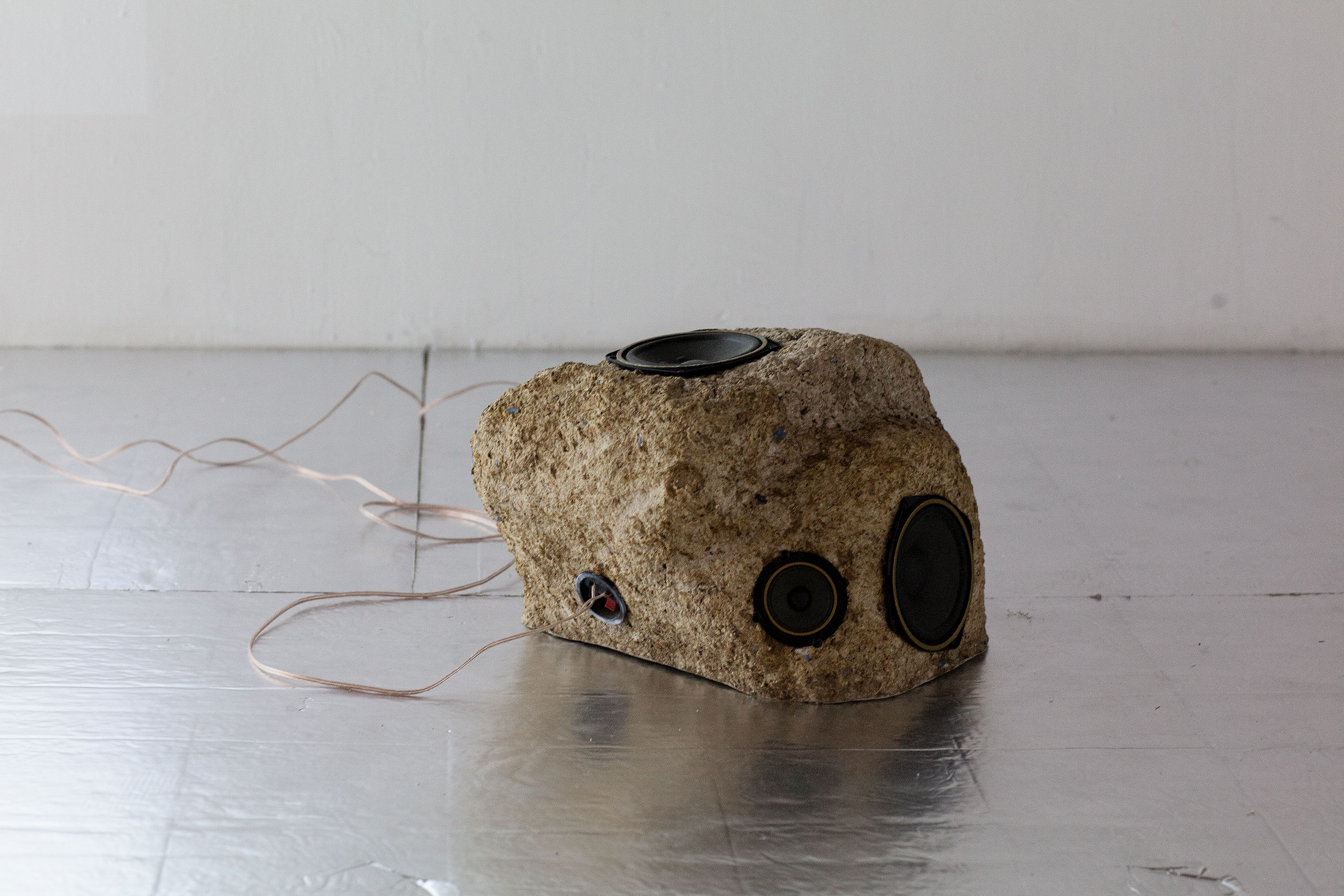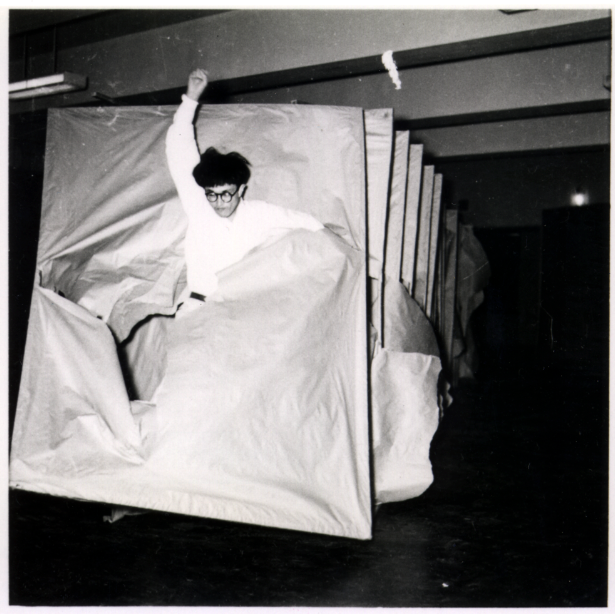
The jointed, double video projection in The Landscape is Motorized, a collaborative multi-media installation by Gregory Ruppe and Timothy Harding.
I’m late on this—the show I am about to review closed last weekend. It has likely been packed up and moved, making space for the next thing. Art shows are like theater that way: here and then gone; quick, urgent, hopefully potent. So while you can’t go see The Landscape is Motorized anymore, a collaborative work by Gregory Ruppe and Timothy Harding at 500X, I write this in hopes that someday you will, when it gets installed again somewhere else, as it should, with some acclaim.
I saw The Landscape is Motorized at the tail end of a long Dallas Art Fair Saturday. I was elevated by the day—the fair was the best yet; the Shamrock Hotel studios had a great smattering of works by artist teams, many of which I wanted to casually pilfer off the walls; I’d met a kindred spirit in artist Kristen Cochran at her delightful show at RE Gallery; and I’d gone out on an actual, unhurried dinner date with my partner-in-crime at which I had lots of food and wine. It was a good night.
When I got to 500X after all of these tidy encouragements, I was worried my mood would be quickly dampened. 500X has, in recent years, seemed like an outpost for artists who are afraid of the world, the Art one and the Real one. The space can feel like a holdover from college, a place where artists make small gestures related to art, but very infrequently art itself. It’s frustrating because 500X is a great big space with lots of potential and a wonderful history of being a seedbed for vigor and brawn. I’m not sure what’s out of whack in the equation of imagination and organization that it takes to run an art space, but something needs fixing in order to connect it to the virile art energies that Dallas is fostering these days.
I had a slim but vibrant hope that Gregory Ruppe, an artist whose panache and aesthetic sense I greatly admire, was going to redeem the gallery a little. He, and his cohort Timothy Harding, did not fail. Through a series of concise and thoughtful interventions, the team managed to engender 500X anew for me—or at least the upper right-hand corner of it, the project space on the second floor.
Gorgeous signage on a floating wall with a light embedded in it’s edge made a gold-glowing vestibule, and helped create the requisite sense of anticipation for the installation’s high-speed theatrics. Behind the wall, viewers were met with a silver glow, from a diptych of projected images reflecting off a floor of foil-covered foam insulation. The sensation of walking on the resilient foam was uncanny, heightening awareness of each step’s force. A host of heel prints pocked the surface of the floor from prior visits. As I adjusted myself to the space, another visitor’s heel suddenly sank into the foam with a loud pop (!).
After admiring how the guys had cut the foam floor to be nearly, but not quite, flush to the wall—a simple but satisfying technical detail that spoke volumes about their acumen, I let myself notice what else was going on in the little room. A sandy-colored paper maché rock (about the size of a fat cat) sat at on the floor at the far side; thin nude cords tangled out and around it and back into the wall. Speakers embedded in the rock emitted a discordant and jumbled noise. Two projected “screens” on the wall met in the corner, splaying video images out into wings on either side. Focusing on one of the fast-paced, kaleidoscopic, colorful and disorienting videos individually felt like watching the rushing sides of a dark tunnel from a train window. Looking at the corner where the two screens met gave the sensation of driving very, very fast: hints of objects blurred past—some decipherable, others just color and motion. Body and mind struggled to meet somewhere; feet struggled to gain balance on the malleable floor; eyes to grab onto something and hold it in view on the whizzing screens—but never really could.
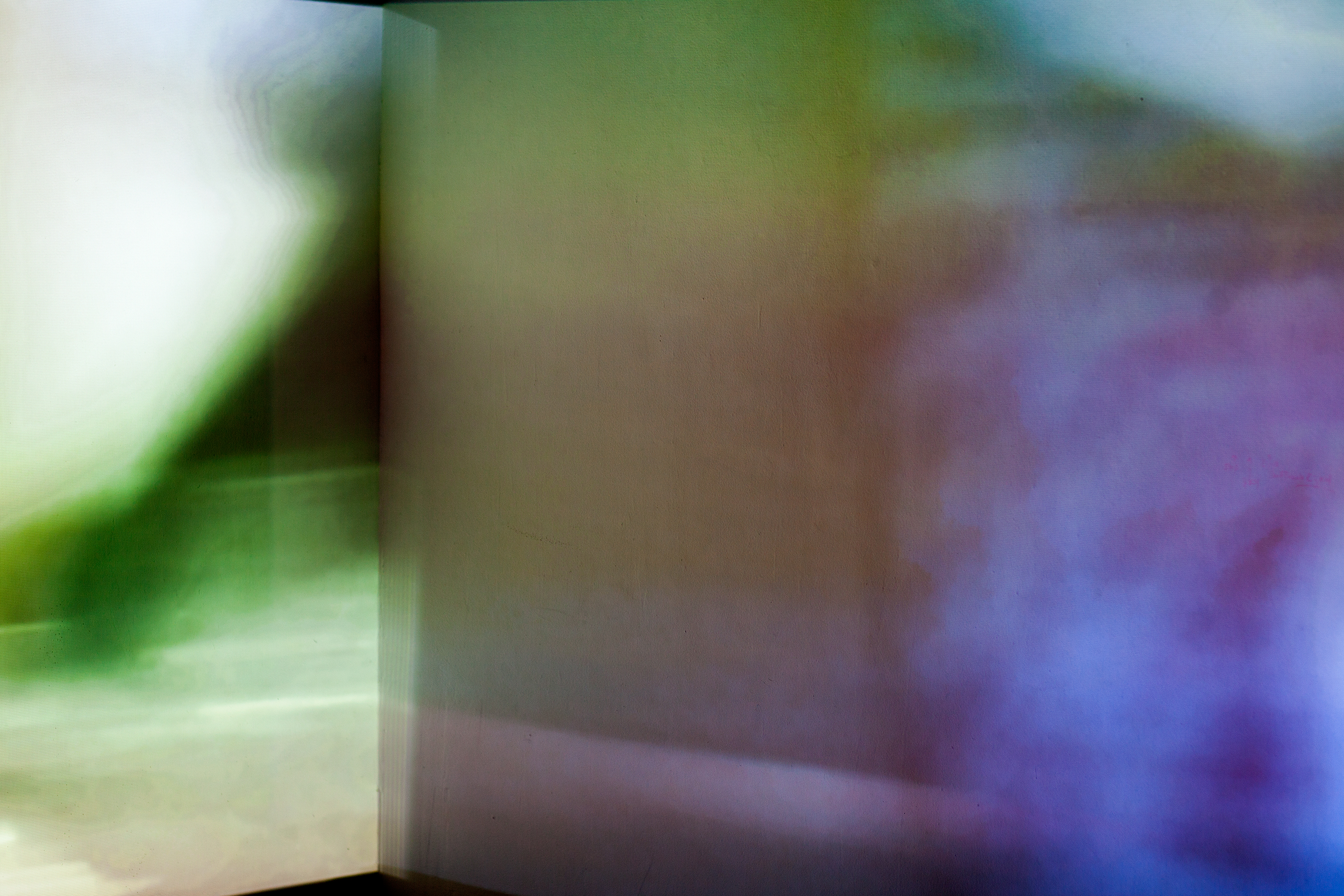 To render that feeling of speed and transience in the video, I assumed Ruppe and Harding had filmed out the window of a moving car and sped up the footage. But then, I kept noticing little domestic, interior details in the film, like a lit computer screen or a hand lifting and adjusting what looked like paper. I had to know how the videos were shot. It turns out, as Ruppe informed me, that they were made by mounting a camera to a record player, setting the player on a platform, and letting it spin, filming, while the artists quickly re-arranged objects around it to create the illusion of a changing landscape. The artists also used various lights and strobes to heighten the effect. The sounds emanating from the paper maché rock were recordings of the camera rotating on the turntable. What looks like a speeding, colorful landscape is only the contrived imitation.
To render that feeling of speed and transience in the video, I assumed Ruppe and Harding had filmed out the window of a moving car and sped up the footage. But then, I kept noticing little domestic, interior details in the film, like a lit computer screen or a hand lifting and adjusting what looked like paper. I had to know how the videos were shot. It turns out, as Ruppe informed me, that they were made by mounting a camera to a record player, setting the player on a platform, and letting it spin, filming, while the artists quickly re-arranged objects around it to create the illusion of a changing landscape. The artists also used various lights and strobes to heighten the effect. The sounds emanating from the paper maché rock were recordings of the camera rotating on the turntable. What looks like a speeding, colorful landscape is only the contrived imitation.
Knowing that the world on the screens is miniature, constructed and artificial is a kind of fall from grace, shrinking the world from an open and peripatetic experience into an enclosed and isolated one. It’s the difference, let’s say, between a mountain peak and snow globe.
For The Landscape is Motorized, Ruppe was influenced by Gutai artist Saburo Murakami’s 1956 piece Passing Through in which the artist ran through a series of paper walls, forming a tunnel with his body. The reference seems apt, as each piece creates a contrived experience that is analogous to some real-world one: jumping through glass, perhaps, in the case of Murakami’s; driving fast, in the case of Ruppe and Harding. Both pieces allow the body’s interaction with the space to leave evidentiary marks—Murakami’s tunnel through the framed paper, Ruppe and Harding’s heel prints on the foil floor. But, unlike Murakami’s simple and elemental piece, The Landscape is Motorized is dense with the scrims and filters of digital technology. That difference sets up a poignant corollary: as with Murakami’s action of smashing his body through thick paper walls, an equal amount of force is required from viewers of Ruppe’s and Harding’s work — a concerted effort of the body and the will to endure the disorienting effect of the false frame to which we subject ourselves.
The Landscape is Motorized photos are by Kevin Todora.


